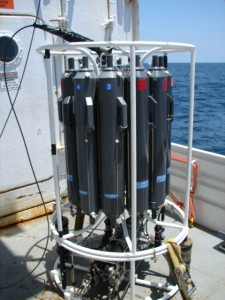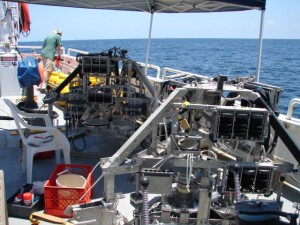Mud, Water, and a Huge Refrigerator…
After a delicious breakf ast, compliments of Kim, our on-board Chef, we headed out for CTD preparations. Bill Flanning spent some time teaching Cris and me how to set-up, deploy, and recover the CTD. CTD stands for Conductivity, Temperature, Depth; it’s an instrument that is sent down to the depths to record these measurements and collect water samples. It is brought up at a controlled speed and held at various depths to measure CTD as well as to collect water samples at indicated depths. In addition to measuring CTD, the instrument also determines salinity and oxygen levels of the water. The scientists on board are specifically interested in studying zones that are hypoxic (devoid or lacking in oxygen), so they have used trial runs of the CTD to determine oxygen levels in various locations within a couple of miles of each other to determine the locations of the lowest levels of oxygen.
ast, compliments of Kim, our on-board Chef, we headed out for CTD preparations. Bill Flanning spent some time teaching Cris and me how to set-up, deploy, and recover the CTD. CTD stands for Conductivity, Temperature, Depth; it’s an instrument that is sent down to the depths to record these measurements and collect water samples. It is brought up at a controlled speed and held at various depths to measure CTD as well as to collect water samples at indicated depths. In addition to measuring CTD, the instrument also determines salinity and oxygen levels of the water. The scientists on board are specifically interested in studying zones that are hypoxic (devoid or lacking in oxygen), so they have used trial runs of the CTD to determine oxygen levels in various locations within a couple of miles of each other to determine the locations of the lowest levels of oxygen.
After 4 trial runs of the CTD, Jim, Silke, Will, Kanchian, and Doug were able to pinpoint an area that has low enough oxygen levels for their research. It was then and there that they deployed the multi-corer. The multi-corer is a device that sends multiple tubes into the sediment to collect samples of mud while maintaining the sequential dignity of the mud’s layers. BUT, alas, science is about trials and mistrials. The initial attempt at coring didn’t collect enough sediment for the researchers to perform their tests. The multi-corer was brought back up to the surface and calibrated to make it core a little bit deeper and deployed again. The multi-corer was brought up a second time. This time the samples were adequate and the scientists had a good enough quality sample to take back to their labs. They rushed the collected sediment samples to the “cold-room” where they would be analyzed quickly and efficiently. Since the temperature of the water at the bottom (about 30 m in this case), is significantly less than the surface temperature, it is important to get the samples into the cold room quickly. Since reaction rates tend to be faster at higher temperatures, keeping them cool preserves the samples and helps them to remain as close as possible to their bottom chemistry.
After dinner Dr. Will Berelso n will deploy his Lander. The Lander is a device that is set on the bottom of the sea floor and left there for a day. Over the course of the following 24-hours water samples will be collected by a device that will suction up water into collection tubes at indicated times. The Lander will be collected tomorrow and the water samples analyzed. In addition to deploying the Lander the team will also perform another multi-core just before the sun sets on our day and on the month of July.
n will deploy his Lander. The Lander is a device that is set on the bottom of the sea floor and left there for a day. Over the course of the following 24-hours water samples will be collected by a device that will suction up water into collection tubes at indicated times. The Lander will be collected tomorrow and the water samples analyzed. In addition to deploying the Lander the team will also perform another multi-core just before the sun sets on our day and on the month of July.
More to come in August, Wessal


 July 31, 2011
July 31, 2011 






Recent Comments